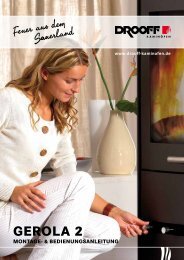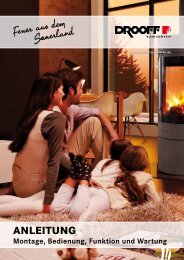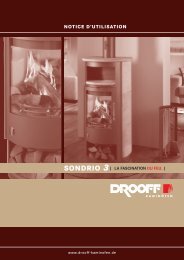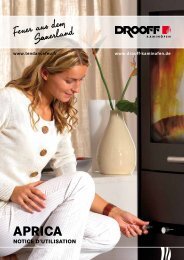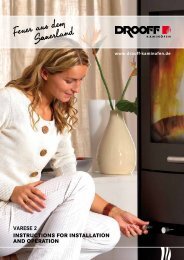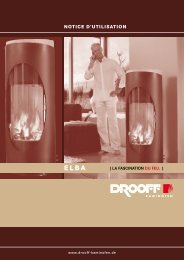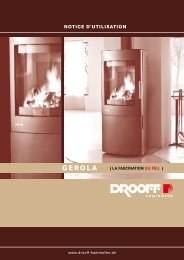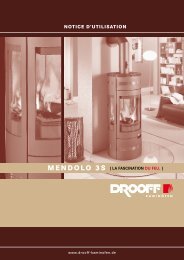INSTRUCTIONS FOR INSTALLATION AND OPERATION elba
INSTRUCTIONS FOR INSTALLATION AND OPERATION elba
INSTRUCTIONS FOR INSTALLATION AND OPERATION elba
Create successful ePaper yourself
Turn your PDF publications into a flip-book with our unique Google optimized e-Paper software.
OPERATING <strong>INSTRUCTIONS</strong> Page 11<br />
w w w. d r o o f f - k a m i n o f e n . d e<br />
FUNCTION OF STOVE<br />
n Primary air is required for heating up the stove and for burning mineral fuels e.g. lignite<br />
briquettes. The primary air is sucked into the fire chamber from below, in most cases<br />
through the grate.<br />
n Secondary or "glass cleaning" air is required for burning long-lasting materials such as<br />
logs, wood briquettes and lignite briquettes. Secondary air enters the fire chamber from<br />
above. It also serves to keep the glass window clean for as long as possible (see notes on<br />
page 14).<br />
n Tertiary air is additional secondary air. With most stoves, the tertiary air is set by the<br />
manufacturer and cannot be changed. However, this varies from one stove to another.<br />
n Depending on type, DROOFF stoves are fitted either with a shaker grate or a fixed grate.<br />
The primary air flowing through the grate to the fire helps to cool the grate. For this reason<br />
it should be kept free at all times.<br />
n All DROOFF stoves are fitted with an ash box. The ash falls through the grate into the box.<br />
The amount of ash created depends on the type and amount of fuel burned and should<br />
be emptied every few days.<br />
n DROOFF stoves are designed according to type 1. This indicates a simple but effective<br />
safety system. Should you forget to close the stove door after stoking it, it will close automatically<br />
thereby preventing burning wood from falling out. However, always make sure that<br />
the door to the fire chamber is properly closed at all times.<br />
n Most DROOFF stoves can be connected to an external source of fresh air. An external air<br />
supply is generally required when the space where the stove is standing is very confined. In<br />
this case, most of the air is supplied to the fire chamber from outside. A qualified heating<br />
engineer will tell you whether an outside connection is necessary in your case.<br />
Important note: if your stove does not receive air from outside, make sure that the room<br />
has a sufficient supply of fresh air. The stove requires approximately 4 cubic metres of<br />
air to burn 1 kg of wood!<br />
DROOFF Kaminöfen — Feuer aus dem Sauerland




